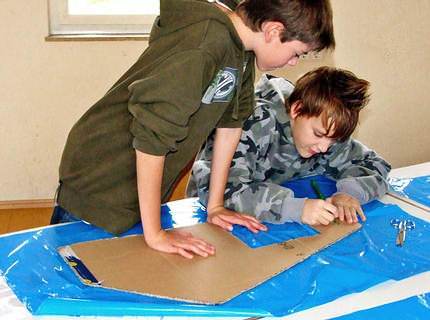source: www.youthwork-practice.com | 2000 Games, Devotions, Themes, Ideas and more for Youth Work
only for private using
Crafting a kite with tissue paper

Crafting a kite
© www.youthwork-practice.com
As soon as the trees shed their leaves, autumn is in full swing. The stormy season is perfect to make a kite. While there are numerous flight and stunt kites to choose from on the market, nothing beats a homemade kite. At the same time, if it is not windy, your kites make for great decorations in your room.
Chilly days are a great time to craft your kite and have a cup of hot cacao at the same time. The following instructions are easy enough for children to follow and craft their own kits. However, there should always be an adult around to lend a hand if it gets too hard after all.Autumn is kite time. Go and let your kite fly!
When the wind howls around the houses and the temperatures drop, the annual kite season has arrived. A very attractive time for all kids and kite lovers. Fields and large meadows are the ideal places to fly your kite.
Sure, you could buy a kite just as well. But making one yourself is so much more fun. Here I will give you all the instructions you need.
Instructions: Paper Kite DIY
Those are the materials you will need for your kite:
- DIN A2 sheet craft cardboard or paperboard
- DIN A2 sheet of tissue paper
- 2 round wooden bars (1 x 60 cm long, 1 x 22 cm long and 4 mm thick each)
- 1 cross connector, diameter 4 mm
- Connector for the corners
- Markers for painting
- Crepe paper
- 1 key ring
- Kite string
- Glue
- 4 metal eyelets
- Ruler and triangle
- Saw
Begin by drawing your kite
To cut the tissue paper to the right size and shape you will need a template, which you make from the cardboard.
First, draw a 60-cm line on the cardboard. At a length of about 48 cm draw a cross line at a 90o angle. Those are the lines where you put the rods later on. Now cut the template along the outlines, out it on the tissue paper and cut it out as well.
Draw the two points on the paper, where the string will go. The pierce them carefully. The first point is on the cross, the other one about 4.5 cm inside the lower tip.
After all the important measurements are on the kite, you can start to paint your kite colourful. Use whatever medium you have available. There are no limits to your creativity.
Now attach the rods
You do that with a cross connector. Alternatively, you could tie the cross with a tear resistant cord, but a connector works better.
To connect the rods with the cross connector, you have to saw them into half.
But be careful: If the rods are not exactly cut in the middle, the kite will drift to one side, and it will crash sooner.
Next, attach the string. Do that before you connect the outer corners with the connector. Make sure the knot is right above the cross in the middle. Then pull the string through the hole in the tissue paper, right above the cross connector to the front of the kite.
Covering the kite with tissue pape
To give the tissue paper a greater hold, put an approx. 2 mm deep groove on the rods and let the kite string run through. To give it, even more, hold, glue it down as well.
Next step: get the tissue paper you have cut out already put it on the “kite skeleton” and run the glue and then the string through the groove. Fold the ends over and glue down as well.
The covering will be more stable with connectors at the end of the rods. This will also save you quite some work because all you have to do is to stick the connectors on and you don’t need to make the grooves. You will need to make holes in the outside corners of the kite, which you need to stabilise with metal eyelets so that they don’t tear. Finally, the connectors are fixed to the holes through the kits string.
The Kite’s Tail
Now it is time to create the colourful kite’s tail. However, consider the tail is not only for decoration, but it will also give your kite an even and steady flight.
First, you will need a 1,5 – 2 m long string or rope. The crepe paper you need to create loops and then attach them to the rope in a distance of about 10 – 20 cm. Also, you can use an adhesive tape to give it more strength.

Crafting a kite
© www.youthwork-practice.com
When the tail is finished, attach it to the rod. Again, use an adhesive tape to secure the tail.
For the kite to fly, you have to pull the end of the string to the front of the kite to the lower point of traction and then secure it loosely. Use a bay node to attach the key ring to the loose string at the front of the kite. To do so, you need to make a loop and pull it through the key ring and then down to the end of the string. After the loop is secured into place, you can move the bay node to adjust the kite. Finally, you attach the steering rope to the key ring. – Now your kite is ready to conquer the sky!
[ © www.youthwork-practice.com | 2000 Games and Ideas for Youth Work ]






